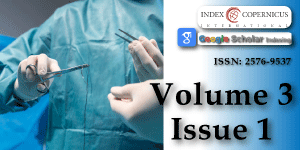Iarogenic Bile Duct Injuries: Repairs Feasibility
Main Article Content
Abstract
Due to laparoscopic cholecystectomy there is increase in the bile duct injuries. It was 0.2% to 0.4% during open opposed to 0.6% to 0.8% during laparoscopic. Included in the study were 22 patients, 19 patients with two redo operated upon. Between Feb. 1999 to Nov2017 and 3 referral cases. The treatment options were end to end anastomosis and hepaticojejunostomy. Regarding the injuries, according to Stresberg there were 2A .4D injuries with injury in the lateral aspect of the ducts, 8 E1, with hepatic stump > 2cm., 5 E2 with hepatic stump < 2cm. The three referral cases were choledochodoudonostomy E1, and E2. They were treated with si ligation of cystic in two cases, anastomosis in seven cases. The remaining fifteen cases with hepaticojejunostomy .Conclusions: The risk is more proximally. After complex injuries diversion is the best while with simple end to end was acceptable. The insertion of stents has to be individualized according to the situations of each patients and the experience of each surgeon.
Article Details
Copyright (c) 2019 Abdelhamid MS, et al.

This work is licensed under a Creative Commons Attribution 4.0 International License.
Głuszek S, Kot M, Bałchanowski N, Matykiewicz J, Kuchinka J, et al. Iatrogenic bile duct injuries--clinical problems. Pol Przegl Chir. 2014; 86: 17-25. Ref.: https://goo.gl/Vqhoa1
Walsh RM, Henderson JM, Vogt DP, Mayes JT, Grundfest-Broniatowski S, et al. Trends in bile duct injuries from laparoscopic cholecystectomy. J Gastrointest Surg. 1998; 2: 458-462. Ref.: https://goo.gl/k7MtSu
Stewart L, Way LW. Bile duct injuries during laparoscopic cholecystectomy; Factors that influence the results of treatment. Arch Surg. 1995; 130: 1123-1130. Ref.: https://goo.gl/ULBVN3
Branum G, Schmitt C, Baillie J, Suhocki P, Baker M, et al. Management of major biliary complications after laparoscopic cholecystectomy. Ann Surg. 1993; 217: 532-541. Ref.: https://goo.gl/f55RBz
West Cott CJ, Pappas TN. Benign biliary strictures. In Cameron JL (ed). Current surgical therapy: st. Louis, Missouri, Mosby. 1998; 425-434.
Bismuth H. Postoperative stricture of the bile duct. In blumgart LH (ed). The biliary tract: Edinburgh: Churchill Livingstone. 1982; 209-218.
Woods MS, Traverso LW, Kozorek RA. Biliary tract complications of laparoscopic cholecystectomy. Surg Endosc. 1995; 9: 1076-1080. Ref.: https://goo.gl/JhN58y
Strasberg SM, Herti M, Soper Nj. Analysis of the problem of biliary injury during laparoscopic cholecystectomy. J Am Coll Surg. 1995; 180: 101-125. Ref.: https://goo.gl/yFfLgT
Solheim K, Buanes T. Bile duct injury. Int Surg. 1995; 80: 361-364. Ref.: https://goo.gl/JrKQks
Gouma DJ, Obertop H. Operative bile duct injury. In Taylor I and Johnson CD (eds). Recent advances in surgery. London, har court Publishers Limited. 2001; 139-150.
Mercado MA, Orozco H, Martinez LM, del Villar APP, Tielve M, et al. Survival and quality of life after bile duct reconstruction. HPB Surg. 2000; 2: 321-324. Ref.: https://goo.gl/Emehvk
Jamgin WR, Blumgart LH. Operative repair of bile duct injuries involving the hepatic duct confluence. Arch Surg. 1999; 134: 769-775. Ref.: https://goo.gl/pE7NP9
Choi YS, Han HS, Yoon YS, Lee TG, Jang JY, et al. Laparoscopic end-to-end choledochocholedochostomy for bile duct injury during laparoscopic cholecystectomy. Lap endo Adv Surg. 2006; 16: 264-266. Ref.: https://goo.gl/RC8CQ1
Ludwig K, Bernhardt J, steffen H, Lorenz D. Contribution of intraoperative cholangiography to incidence and outcome of common bile duct injuries during laparoscopic cholecystectomy. Surg Endosc. 2002; 16: 1098-1104. Ref.: https://goo.gl/7sdoVt
Lillemoe KD, Melton GB, Cameron JL, et al. Postoperative bile duct strictures: management and outcome in the 1990s. Annsurg. 2000; 232: 430-441. Ref.: https://goo.gl/J2LS1V
De Lédinghen V, Person B, Legoux JL, Le Sidaner A, Desaint B, et al. Prevention of biliary stent occlusion by ursodeoxycholic acid plus norfloxacin: a multicenter randomized trial. Dig Dis Sci. 2000; 45: 145-150. Ref.: https://goo.gl/WNfwrK
Woods MS, Traverso LW, Kozarek RA, Tsao J, Rossi RL, et al. Characteristics of biliary tract complications during laparoscopic cholecystectomy. Am J Surg. 1994; 167: 27-34. Ref.: https://goo.gl/vf3r5X
Flum DR, Koepsell T, Heagerty P, Sinanan M, Dellinger EP. Common bile duct injury during laparoscopic cholecystectomy and the use of intraoperative cholangiography. Arch surg. 2001; 136: 1287-1292. https://goo.gl/vwNaZa
Murr MM, Gigot JF, Nagorney DM, Harmsen WS, Ilstrup DM, et al. Long-term results of biliary reconstruction after laparoscopic bile duct injuries. Arch Surg. 1999; 134: 604-609. Ref.: https://goo.gl/tpzf5e
Mercado MA, Chan C, Orozco H, Cano-Gutiérrez G, Chaparro JM, et al. To stent or not to stent bilioenteric anastomosis after iatrogenic injury. Arch Surg. 2002; 137: 60-63. Ref.: https://goo.gl/PUQACN
Fingerhut A, Dziri C, Garden OJ, Gouma D, Millat B, et al. ATOM, the all-inclusive, nominal EAES classification of bile duct injuries during cholecystectomy. Surg Endosc. 2013; 27: 4608-4619. Ref.: https://goo.gl/R7MsJk
Prasad A, De S, Mishra P, Tiwari A. Robotic assisted Roux-en- Y hepaticojejunostomy in a post-cholecystectomy type E2 bile duct injury. World J Gastroenterol. 2015; 21: 1703-1706. Ref.: https://goo.gl/NwQQXg
Barbier L, Souche R, Slim K, Ah-Soune P. Long-term consequences of bile duct injury after cholecystectomy. J Visc Surg. 2014; 151: 269-279. Ref.: https://goo.gl/ieK3yt





